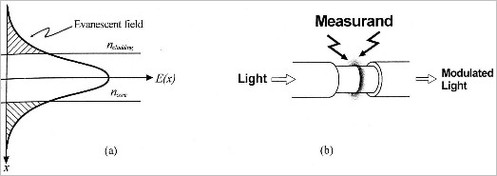
Evanescent field
In this part we will present a method of intensity modulation based on direct interaction of the measurand with the electromagnetic wave. The conventional mono- or multimode fibers guide the way by the well-known phenomenon of total internal reflection. It appears when the Snell-Descartes law is not verified or simply at the interface between a medium with a high refraction index and another medium with a lower refraction index; then the rays which come from definite incidences are totally reflected, however the light will get through the interface and enter farther or closer in the medium with a low refraction index. This part of the electromagnetic field is called evanescent field (see Figure 3-a) and its particularity is to exponentially decrease.

The basic principle of the evanescent field sensor (refer to Figure 3-b) is to make the quantity to measure and this part of the electromagnetic field interact. So it is necessary to come as close as possible to the guiding part (i.e. the core) to obtain enough sensitivity.
The main problem of this kind of sensors is the low interaction between the evanescent field and the measurand. For the waveguides, this interaction is proportional with the depth of the penetration in the cladding. This depth is related to the opto-geometrical parameters of the fibers, which are summed up in the normalized frequency V (see the module about the propagation in the optical fibers). To say it simply, the higher V's value is, the deeper the penetration in the evanescent field is.
The easiest configuration of this sensor is shown on Figure 3-b, where the protective plastic jacket of the fiber has been removed and the cladding has been reduced by polishing or by chemical attacks. Then it is simple to detect chemical species or gaz by choosing adequately the wavelength used. The presence of the measurand will be obvious through the absorption of the evanescent wave, creating leakages and modulating the light intensity.
In order to increase the interaction with the evanescent field, it is possible to use special fibers, like D-fibers or micro-structured fibers [13]. It is also possible to sharpen the fiber by heating it up to its softening temperature and then by stretching it [14]. People frequently resort to putting a thiner or larger layer on the cladding, because as its optical characteristics vary depending on the substance to detect, the evanescent wave will also be affected.
Others sensors use the frustration, or the modification of the total internal reflection, as a principle [15], [16], either by moving the middle near to the heart (displacement sensors) or by varying the refraction index of the medium (refractometers). A big modulation of the light intensity can be obtained through this technique [44].
Finally, the evanescent field sensor can be used in numerous configurations, you just have to make the wave interact directly or indirectly with the measurand.